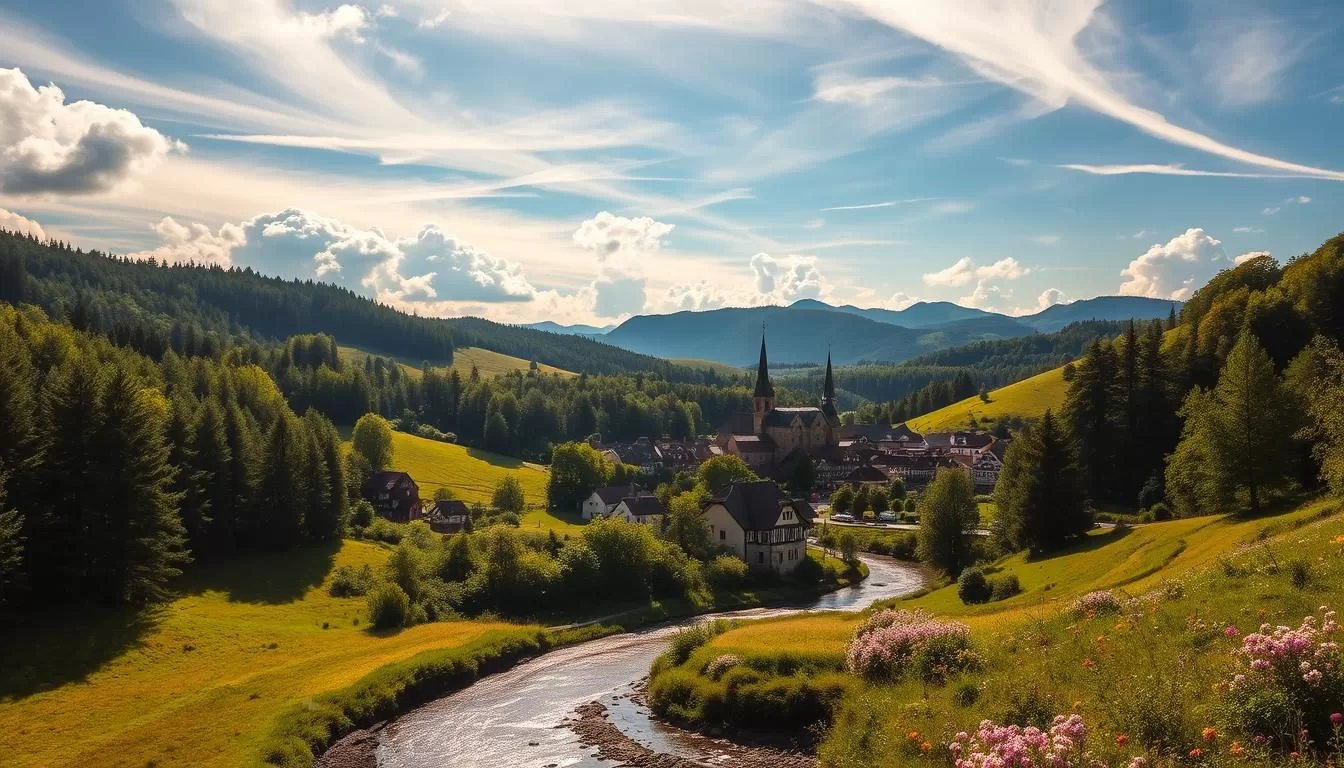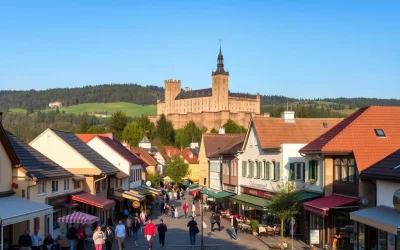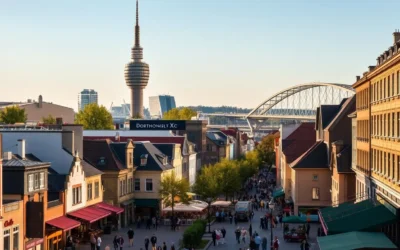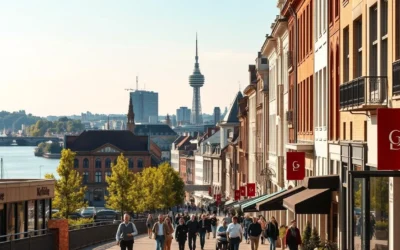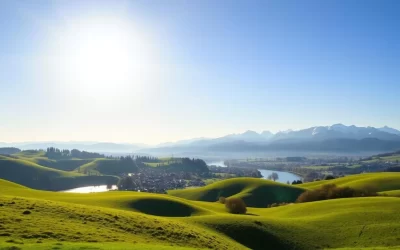✓ Accommodations ✓ Flights ✓ Rental Cars
Planning a trip to Saarland? Timing is everything when it comes to enjoying the perfect weather and unforgettable experiences. This region offers something special every time of the year, from vibrant springs to cozy winters. Whether you’re exploring lush landscapes or attending local festivals, choosing the right day to visit can make all the difference.
This guide will help you navigate the best times to visit, based on weather patterns and cultural events. You’ll learn about average temperatures, rainfall, and seasonal highlights. Planning ahead ensures you avoid crowds and enjoy pleasant conditions during your stay.
Ready to discover the ideal time for your adventure? Let’s dive into the details and make your trip unforgettable.
Introduction: Why Timing is Key for Your Saarland Adventure
Timing your visit wisely ensures you make the most of every moment. The right season can elevate your trip, blending pleasant weather with vibrant cultural events. Understanding the history and traditions of the region helps you align your itinerary with local highlights.
Each city in this area offers a unique charm tied to its seasonal changes. From spring festivals to winter markets, the course of the year shapes the experiences you’ll enjoy. Planning around these events ensures you don’t miss out on the best activities.
Weather plays a significant role in shaping your trip. Mild temperatures in spring and fall make outdoor exploration comfortable. Winter brings cozy markets, while summer is perfect for lively festivals. Knowing these patterns helps you pack appropriately and enjoy every moment.
“The beauty of travel lies in experiencing a place through its seasons.”
Timing also helps you avoid crowds and secure better deals. Visiting during shoulder seasons often means fewer tourists and lower prices. This allows you to explore popular attractions without the hassle of long lines or fully booked accommodations.
Here’s a quick overview of how seasonal changes impact your trip:
| Season | Highlights | Tips |
|---|---|---|
| Spring | Blossoming landscapes, festivals | Pack layers for variable weather |
| Summer | Outdoor events, warm weather | Book accommodations early |
| Fall | Colorful foliage, harvest celebrations | Enjoy fewer crowds |
| Winter | Markets, cozy indoor activities | Bundle up for cold temperatures |
By aligning your visit with the history and culture of the region, you’ll create a memorable journey. Whether you’re exploring ancient landmarks or enjoying modern festivities, timing is the key to unlocking the best experiences.
Overview of Saarland’s Distinct Seasons
Discover the unique charm of each season in this picturesque region. From vibrant springs to cozy winters, every time of year offers something special. The changing weather at various sites influences your travel plans and local experiences.
Understanding these seasonal shifts helps you prepare for your trip. Whether you’re exploring lush landscapes or attending festive markets, knowing what to expect ensures a smooth journey. Let’s dive into the details of each season.
Spring Blossoms and Mild Skies
Spring is a time of renewal, with mild temperatures and blooming landscapes. Average highs range from 10°C to 15°C, making it perfect for outdoor activities. The region bursts into color, offering a feast for the eyes.
This season is ideal for hiking and exploring local festivals. Pack layers to stay comfortable as the weather can vary. Spring’s mild skies create a welcoming atmosphere for travelers.
Winter Magic with Snow and Markets
Winter transforms the region into a snowy wonderland. Temperatures can drop to around 0°C, creating a magical setting. Traditional Christmas markets light up town squares, offering festive cheer.
Bundle up and enjoy cozy indoor activities or explore the snowy outdoors. Winter’s charm lies in its peaceful ambiance and cultural celebrations. It’s a season that truly feels like stepping into another world.
| Season | Average Temperature | Highlights |
|---|---|---|
| Spring | 10°C – 15°C | Blooming landscapes, festivals |
| Winter | 0°C – 5°C | Snowy scenery, Christmas markets |
Each season brings its own energy and opportunities for exploration. By aligning your visit with these seasonal changes, you’ll create unforgettable memories. Whether it’s the mild skies of spring or the snowy magic of winter, the region offers something for everyone.
Detailed Weather Patterns in Saarland
Each month offers unique weather conditions that shape your travel experience. Understanding these patterns ensures you’re prepared for every adventure. From sunny days to occasional rain showers, the region’s climate varies significantly throughout the year.
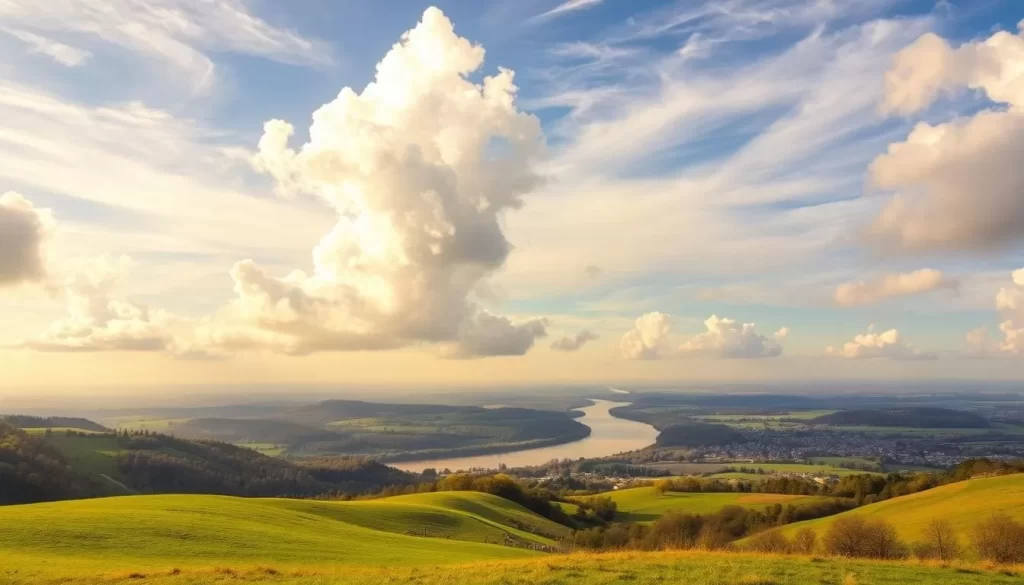
- March: Average highs range from 46°F to 50°F, with lows between 32°F and 37°F. Expect occasional rain and overcast skies.
- April: Temperatures rise to 55°F-58°F during the day, with nights cooling to 38°F-42°F. Rainfall decreases, making it ideal for outdoor activities.
- May: Warmth sets in, with highs of 63°F-66°F and lows of 46°F-49°F. Sunny days dominate, perfect for exploring.
As the year progresses, the weather shifts:
| Month | Average High | Average Low | Rainfall |
|---|---|---|---|
| September | 65°F-68°F | 48°F-52°F | Moderate |
| October | 55°F-59°F | 41°F-46°F | Increased |
| November | 44°F-49°F | 32°F-40°F | High |
These monthly details are crucial for planning your itinerary. Whether you’re visiting in spring or fall, knowing what to expect helps you pack appropriately and enjoy your trip to the fullest.
Best Weather Months: From Warm Summers to Cozy Winters
Finding the perfect time to explore this region can make your trip unforgettable. Each season offers unique opportunities for outdoor adventures and cultural experiences. Whether you prefer warm days or snowy evenings, there’s an ideal time for every traveler.
May is a standout month, with blooming landscapes and mild temperatures. It’s perfect for hiking, sightseeing, and enjoying the outdoors. As the season transitions into summer, the region comes alive with vibrant festivals and outdoor dining. Warm weather creates a lively atmosphere, drawing visitors from near and far.
Summer months, especially June to August, are peak times for tourism. Average temperatures range from 64°F to 68°F, making it ideal for outdoor activity. Festivals, markets, and open-air events are in full swing, offering endless entertainment. However, this popularity means larger crowds, so plan ahead to secure accommodations and tickets.
Winter, on the other hand, offers a cozy charm. Snow-covered landscapes and traditional markets create a magical setting. While temperatures drop to around 32°F, the festive ambiance makes it worth bundling up. It’s a quieter time to visit, with fewer tourists and a peaceful atmosphere.
Aligning your itinerary with these weather-driven activities ensures maximum enjoyment. Whether you’re exploring in the warmth of summer or the tranquility of winter, each visit is backed by historical data for a delightful experience.
Saarland, Germany: Best Months for a Weather-Savvy Trip
Understanding the climate patterns can help you plan a memorable journey. Each time year brings unique weather conditions that shape your travel experience. Knowing what to expect ensures you’re prepared for every adventure, from sunny days to snowy evenings.
Winter, for instance, offers a cold yet charming atmosphere. With average temperatures ranging from 32°F to 40°F, it’s perfect for cozy indoor activities or exploring snowy landscapes. Traditional markets and winter sports add to the season’s appeal, creating unforgettable memories.
Comparing winter to other seasons highlights its unique charm. While spring and fall offer mild weather for outdoor exploration, winter’s snowy scenery and festive ambiance stand out. Understanding these differences helps you choose the right time year for your trip.
Here’s a quick comparison of seasonal conditions:
| Season | Average Temperature | Highlights |
|---|---|---|
| Winter | 32°F – 40°F | Snowy landscapes, markets |
| Spring | 50°F – 66°F | Blooming flowers, festivals |
| Summer | 64°F – 68°F | Outdoor events, warm weather |
| Fall | 48°F – 68°F | Colorful foliage, harvest celebrations |
Using real average temperature data helps you pack appropriately and plan activities. Whether you’re visiting in winter or another season, these insights ensure a stress-free and enjoyable trip.
Seasonal Cultural Festivals and Outdoor Activities
Every season brings its own rhythm, blending nature’s beauty with cultural celebrations. From blooming landscapes to snowy evenings, the region’s festivals and outdoor activities are perfectly timed to match the spirit of each season. These events not only highlight local traditions but also offer unique experiences for visitors.
Spring Festivities and May Traditions
Spring is a time of renewal, marked by vibrant festivals and outdoor activities. As nature blooms, the region comes alive with maypole dances and traditional celebrations. Mild rain may occasionally fall, but it only adds to the charm of the season.
One of the highlights is the Baumblütenfest, the largest fruit wine festival, held at the beginning of May. This event celebrates the region’s agricultural heritage with music, food, and wine. Another tradition is Spargelzeit, the white asparagus season, which runs from mid-April to June. Visitors can enjoy fresh asparagus dishes at local restaurants and markets.
These spring festivities encourage outdoor exploration, from hiking through blooming trails to attending open-air events. The variation in weather adds excitement, making every day a new adventure.
Winter Markets and Lively Beer Gardens
Winter transforms the region into a magical wonderland, with snow-covered landscapes and festive markets. Traditional Christmas markets light up town squares, offering handmade crafts, warm drinks, and seasonal treats. The cozy atmosphere is perfect for creating lasting memories.
Lively beer gardens also play a key role in winter celebrations. These gatherings bring people together to enjoy hearty meals and local brews. The seasonal snow enhances the charm, making these spaces even more inviting.
These cultural events influence the timing of trips, encouraging visitors to plan personalized itineraries. Whether you’re exploring in spring or winter, the region’s festivals and activities ensure a memorable experience.
Practical Travel Tips for Packing and Budgeting
Preparing for your journey involves more than just picking a destination—it’s about being ready for whatever the weather throws your way. Packing smart and budgeting wisely can make your trip smoother and more enjoyable. Whether you’re traveling in the warmth of summer or the chill of winter, these tips will help you stay prepared.
Packing Essentials for Variable Weather
Weather can change quickly, so packing versatile items is key. Layered clothing is a must, allowing you to adapt to sudden temperature shifts. A waterproof jacket is essential for unexpected rain, while comfortable footwear ensures you’re ready for long days of exploration.
Here’s a quick checklist to help you pack efficiently:
- Layered clothing: Lightweight sweaters, long-sleeve shirts, and a warm jacket.
- Waterproof gear: A sturdy raincoat or umbrella to stay dry.
- Comfortable shoes: Supportive footwear for walking and hiking.
- Travel adapters: Essential for keeping your devices charged.
The best time to pack is when weather forecasts show potential changes. Staying informed helps you avoid last-minute stress and ensures you’re ready for any conditions.
Budgeting Tips for a Stress-Free Trip
Traveling during peak seasons can be expensive, but planning ahead can save you money. Booking accommodations and transportation early often leads to better deals. Consider visiting during shoulder seasons when prices are lower, and crowds are thinner.
Here are some practical strategies to keep your budget in check:
- Book early: Secure flights and hotels months in advance.
- Travel off-peak: Avoid high-demand periods to save on costs.
- Pack snacks: Reduce food expenses by bringing your own.
- Use public transport: It’s often cheaper than renting a car.
Understanding weather patterns throughout year can also help you plan a budget-friendly trip. For example, traveling during mild seasons often means fewer expenses on heating or cooling.
By combining smart packing with careful budgeting, you’ll enjoy a stress-free and memorable journey. Preparation is the key to making the most of every moment.
Day-to-Day Temperature, Rainfall, and Cloud Coverage Insights
Understanding daily weather changes can transform your travel experience. Knowing the specifics of temperature, rainfall, and cloud coverage helps you plan activities with confidence. These metrics are collected over a period, providing reliable data to energize your itinerary.
Daily temperature fluctuations can vary significantly. Mornings might start cool, with highs peaking in the afternoon. For example, in spring, temperatures often range from 50°F to 66°F. This variation allows for comfortable outdoor exploration during the day.
Rainfall is another critical factor. On average, spring sees moderate rain, while summer tends to be drier. Knowing these patterns helps you pack appropriately and avoid unexpected disruptions. Cloud coverage also plays a role, with sunny days ideal for sightseeing and overcast skies perfect for indoor activities.
Here’s a breakdown of daily weather metrics:
| Weather Metric | Spring | Summer |
|---|---|---|
| Average Temperature | 50°F – 66°F | 64°F – 68°F |
| Rainfall | Moderate | Low |
| Cloud Coverage | 40% – 60% | 20% – 40% |
Using these insights, you can schedule activities when conditions are most favorable. For instance, plan hikes on sunny days and visit museums during rainy periods. This approach ensures a comfortable and enjoyable trip.
Weather data isn’t just numbers—it’s a tool to enhance your travel experience. By staying informed, you’ll make the most of every moment, no matter the forecast.
Navigating Crowds and Seasonal Pricing for a Stress-Free Trip
Smart planning can help you avoid crowds and save money during your trip. Seasonal changes like snowfall and weather shifts influence both pricing and tourist numbers. By understanding these trends, you can make informed decisions that enhance your experience.

Off-Peak Strategies to Save
Traveling during off-peak times can unlock hidden savings and quieter destinations. For example, visiting in late fall or early spring often means fewer tourists and lower prices. You can save up to 30% on flights and accommodations during these periods.
Here are some practical tips for off-peak travel:
- Plan around local events: Avoid peak festival seasons to enjoy lower costs.
- Embrace the weather: Mild temperatures and occasional snowfall can create unique experiences.
- Flexible dates: Adjust your itinerary to take advantage of mid-week discounts.
Booking Early for Peak Periods
If you prefer traveling during peak seasons, booking early is essential. Securing flights and accommodations months in advance can help you avoid last-minute price hikes. For instance, travelers who booked six months ahead saved an average of 20% on their trips.
Here’s why early booking matters:
- Better rates: Early birds often get access to discounted prices.
- Wider options: Popular hotels and flights fill up quickly, so early booking ensures availability.
- Peace of mind: Knowing your plans are set reduces stress and allows you to focus on enjoying your trip.
Understanding seasonal trends allows you to manage expectations and plan accordingly. Whether you’re exploring during a snowy winter or a vibrant summer, thoughtful preparation ensures a stress-free and affordable travel experience.
Exploring Major Cities in Saarland: Weather and Culture
Exploring the major cities in this region offers a blend of culture and climate. Each urban center has its own charm, shaped by unique weather patterns and vibrant traditions. From bustling streets to serene parks, the interplay of pleasant weather and local culture creates unforgettable experiences.
Highlights of Saarbrücken’s Unique Climate
Saarbrücken stands out with its distinct climate, offering mild temperatures and a welcoming atmosphere. The city’s weather changes by the minute, especially during fall, creating a dynamic backdrop for exploration. Whether you’re strolling through the historic Old Town or enjoying the Saar River, the pleasant weather enhances every moment.
Here’s what makes Saarbrücken’s climate special:
- Fall magic: Crisp air and golden foliage set the stage for cozy walks and outdoor cafes.
- Minute-by-minute changes: The weather shifts quickly, adding excitement to your day.
- Cultural vibes: Calm weather invites you to explore museums, markets, and festivals.
Urban weather trends also influence travel logistics. For example, mornings might start cool, warming up by midday. This variation allows you to plan activities around the most comfortable times. Saarbrücken Airport’s climate data shows how these minute changes can impact your schedule, so staying informed ensures a smooth trip.
“The beauty of Saarbrücken lies in its ability to surprise you—whether it’s a sudden burst of sunshine or a gentle fall breeze.”
Key attractions like the Saarbrücken Castle and Ludwigskirche are best enjoyed when the weather is calm and inviting. The city’s blend of history and modernity shines brightest under clear skies. By aligning your visit with these weather patterns, you’ll create a memorable journey filled with cultural discoveries.
The Influence of Weather on Local History and Traditions
The weather has always played a pivotal role in shaping the culture and traditions of this region. From snowy winters to long nights, the climate has deeply influenced how people live, celebrate, and tell their stories. Understanding these connections adds depth to your travel experience.
Snowfall, for instance, has left a lasting mark on local folklore. Long winter nights inspired tales of mystery and magic, passed down through generations. These stories often revolve around the challenges and beauty of the season, creating a unique cultural identity.
Specific locations within the region have their own historical narratives due to micro-climates. For example, areas with heavier snowfall developed traditions centered around winter survival and community bonding. These practices continue to influence festivals and daily life today.
Historical events also intertwine with seasonal weather patterns. Harsh winters often shaped decisions during wars or migrations, while mild summers encouraged agricultural innovations. These events are reflected in local museums and cultural sites.
Here’s a glimpse of how weather has influenced traditions:
| Weather Event | Cultural Impact |
|---|---|
| Heavy snowfall | Winter festivals, storytelling traditions |
| Long nights | Cozy gatherings, candlelit celebrations |
| Mild summers | Outdoor markets, harvest festivals |
By exploring these connections, you’ll gain a deeper appreciation for the region’s heritage. Whether it’s a snowy landscape or a starry night, the weather continues to shape the culture in meaningful ways.
Utilizing Regional Weather Data for a Perfect Itinerary
Using regional climate insights can transform your travel plans. Understanding local weather metrics ensures you’re prepared for every adventure. From temperature trends to chance of precipitation, this data helps you design a flexible and enjoyable itinerary.
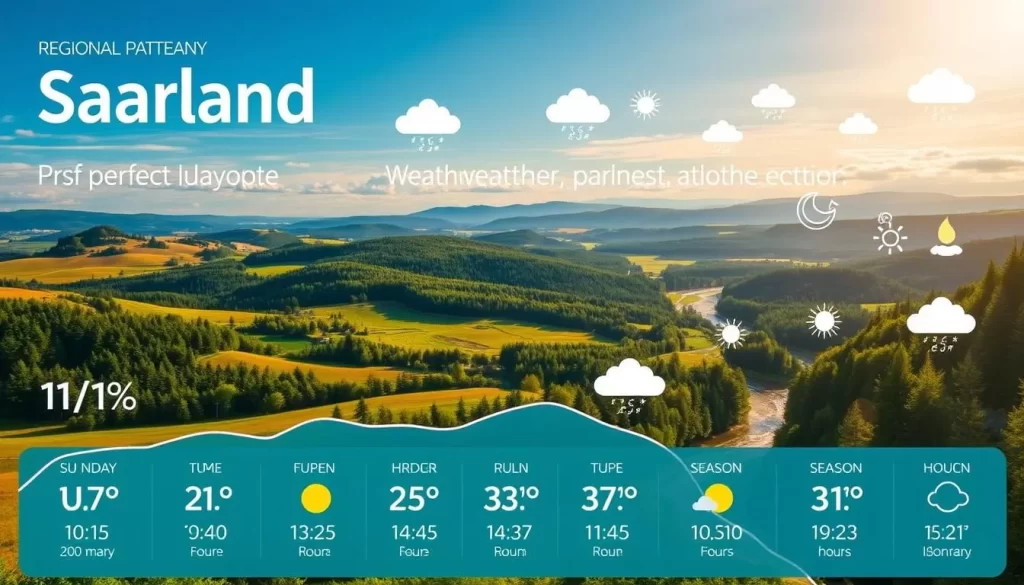
Regional weather data is essential for increasing the chance of a pleasant time visit. By analyzing metrics like average temperatures and rainfall, you can predict trends and schedule activities accordingly. This approach minimizes surprises and maximizes enjoyment.
Understanding Local Climate Metrics
Local climate metrics provide valuable insights for travelers. For example, Saarbrücken Airport’s data shows seasonal temperature fluctuations and tourism patterns. These metrics help you choose the best time visit for outdoor activities or cultural events.
Here’s how to use this data effectively:
- Plan around weather trends: Schedule outdoor activities during dry periods and indoor visits during rainy days.
- Monitor tourism scores: Avoid peak seasons to enjoy fewer crowds and better deals.
- Stay flexible: Adjust your itinerary based on real-time weather updates.
By leveraging these insights, you can create a stress-free and memorable trip. Whether you’re exploring cities or countryside, precise weather data ensures you’re always prepared.
| Metric | Importance | Example |
|---|---|---|
| Temperature | Helps plan outdoor activities | Spring: 50°F – 66°F |
| Rainfall | Guides packing and scheduling | Summer: Low rainfall |
| Tourism Scores | Indicates crowd levels | Winter: Fewer tourists |
Using regional weather data not only enhances your time visit but also ensures a smooth and enjoyable experience. Stay informed, plan ahead, and make the most of every moment.
Enjoying Outdoor Adventures with Comfort and Energy
Outdoor adventures in this region are best enjoyed when aligned with the local calendar and seasonal energy. Each week brings new opportunities to explore, especially during the vibrant spring bloom. By syncing your activities with nature’s rhythm, you’ll experience the region at its finest.
Spring is a particularly exciting time, with the landscape bursting into life. The energy of the region shifts week by week, offering fresh experiences for hikers, bikers, and nature enthusiasts. Trails lined with blooming flowers and crisp air make it the perfect season for outdoor exploration.
Here are some activities to consider during this time:
- Hiking: Explore scenic trails that come alive with spring bloom.
- Biking: Ride through picturesque routes, enjoying the mild weather.
- Exploring natural sites: Visit parks and gardens to witness the seasonal transformation.
Understanding the local calendar can greatly enhance your experience. Many events, like festivals and markets, are timed to coincide with the season’s peak. Planning your adventures around these events ensures you don’t miss out on the region’s cultural highlights.
Here are some practical tips for making the most of your outdoor adventures:
- Check the calendar: Align your visit with local events and optimal weather conditions.
- Pack smart: Bring layers and waterproof gear to stay comfortable.
- Stay flexible: Adjust your plans based on real-time weather updates.
By embracing the energy of each week and the beauty of the spring bloom, you’ll create unforgettable memories. Whether you’re hiking through lush trails or biking along scenic routes, the region offers endless opportunities for adventure.
Embracing the Change: From Dawn to Dusk in Saarland
From the first light of day to the last glow of sunset, the landscape transforms dramatically. The climate shifts subtly, creating a dynamic backdrop for your adventures. As the sun rises, the sky is painted with soft pastel hues, setting a serene tone for the morning. This is the perfect time to explore quiet trails or enjoy a peaceful moment by the water.
By midday, the color of the sky deepens, and the energy of the region intensifies. The warmth of the sun encourages outdoor activities like hiking or cycling. Tourists often find this time ideal for visiting landmarks or participating in local events. The vibrant light enhances every detail, making it a photographer’s dream.
As evening approaches, the sky transforms once again. The golden hour bathes the landscape in a warm glow, creating a magical atmosphere. This is a favorite time for capturing stunning photos or simply soaking in the beauty of the surroundings. The climate cools, offering a refreshing break from the day’s heat.
Dusk brings a sense of calm, with the sky shifting to rich purples and blues. This is a wonderful time to enjoy cultural experiences like evening markets or open-air concerts. The changing color palette sets the stage for unforgettable moments. Tourists often describe this time as the most enchanting part of the day.
By planning your day around these natural rhythms, you can fully embrace the region’s beauty. Whether you’re an early riser or a sunset enthusiast, each moment offers something special. The interplay of light and climate ensures that no two days are the same, making your visit truly unique.
“The sky’s transformation from dawn to dusk is a daily masterpiece, inviting you to pause and appreciate the moment.”
For more insights into how local traditions are shaped by these daily changes, explore this detailed resource. It highlights the cultural significance of these natural phenomena, adding depth to your travel experience.
Crafting a Flexible Itinerary Based on Seasonal Shifts
Creating a travel plan that adapts to seasonal changes ensures a smoother and more enjoyable experience. Flexibility is key when dealing with weather variations and local events. By understanding the difference between seasons, you can make informed decisions that enhance your trip.
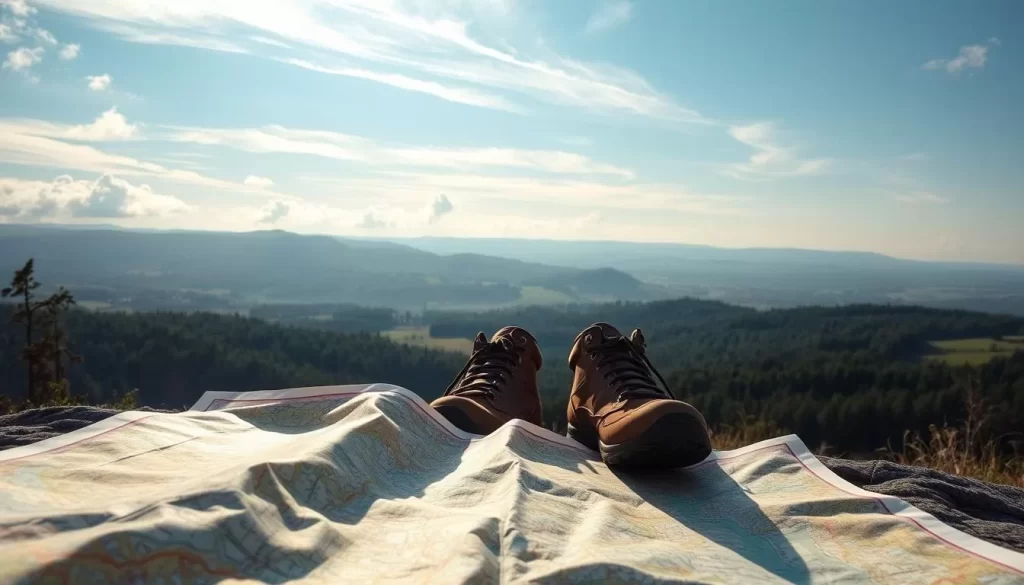
Planning Around Local Events
Local events often shift due to weather changes every day. Festivals, markets, and outdoor activities are influenced by the season. Checking the event calendar and weather forecasts helps you align your plans with the best opportunities.
For example, spring festivals may move indoors if rain is expected. Winter markets might extend hours during colder evenings. Staying informed ensures you don’t miss out on the highlights.
Adjusting to Weather Variations
Weather can change rapidly, so it’s essential to stay adaptable. A sunny morning might turn into a rainy afternoon, or a chilly evening could follow a warm day. Packing layers and having backup plans allows you to adjust seamlessly.
Here’s a quick comparison of seasonal weather patterns:
| Season | Weather | Tips |
|---|---|---|
| Spring | Mild, occasional rain | Bring a light jacket |
| Summer | Warm, sunny | Stay hydrated |
| Fall | Cool, variable | Pack layers |
| Winter | Cold, snowy | Bundle up |
Using tools like weather apps and travel planners can help you stay ahead of changes. These resources provide real-time updates, making it easier to adjust your itinerary every day.
“Flexibility in travel planning turns unexpected changes into memorable adventures.”
By embracing the difference between seasons and staying prepared, you can create a trip that’s both enjoyable and stress-free. Whether it’s a sunny hike or a cozy indoor event, adaptability ensures you make the most of your journey.
Conclusion
Your travel experience can be greatly enhanced by aligning your plans with the right timing and weather insights. Choosing the ideal season ensures comfort and allows you to fully enjoy the region’s unique charm. A well-planned itinerary, informed by detailed weather trends, makes every moment of your trip memorable.
This guide serves as a valuable part of your preparation, helping you avoid crowds and make the most of local events. Whether you’re exploring vibrant festivals or serene landscapes, understanding seasonal shifts ensures a smooth and enjoyable journey.
Use these insights to plan your next adventure confidently. By focusing on timing and weather, you’ll create a trip filled with comfort and unforgettable experiences. Let this guide be a part of your travel toolkit, ensuring every detail is perfectly aligned for your journey.
The above is subject to change.
Check back often to TRAVEL.COM for the latest travel tips and deals.
